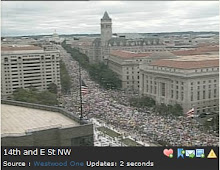If Cap and Trade Doesn't Work, Obama Will Make It Work
Cap and Trade proposes a new national tax of historic proportions
All the talk in Washington is surrounding a government health insurance plan, but there’s a little discussed insurance plan in the Boxer-Kerry cap and trade bill that’s worth some attention. The Senate version of the cap and trade bill includes a section that grants the President the authority to “direct relevant federal agencies” to impose additional greenhouse gas regulations. Senator David Vitter (R-LA) and John Barrasso (R-WY) have been working assiduously to uncover the true costs of cap and trade legislation.
Greenhouse gas concentrations are measured in parts per million (ppm). Many global warming alarmists believe that upper limit on carbon dioxide and other greenhouse gas emissions in order to prevent catastrophic harm is 450 parts per million (ppm). Once we reach that threshold, water will rise to the torch of the Statue of Liberty, California will be an island, the polar ice caps will cease to exist and island nations will no longer be nations but submerged pieces of land. To put the numbers in some perspective, Sharon Begley notes in her Newsweek column that the carbon dioxide concentration is currently at 386 ppm; we were at 280ppm before the Industrial Revolution. If you include the carbon dioxide equivalent greenhouse gases, we’ve arguably reached the 450 ppm threshold. The Boxer-Kerry legislation says that if global greenhouse gas concentrations exceed 450 parts per million of carbon dioxide equivalent:
Sec. 707 Not later than July 1, 2015, and every 4 years thereafter--
`(1) the President shall direct relevant Federal agencies to use existing statutory authority to take appropriate actions identified in the reports submitted under sections 705 and 706 and to address any shortfalls identified in such reports.
The passed House version, Waxman-Markey, also contains language that grant the administration similar authority. So, for those who thought cap and trade legislation would preempt costly regulations, think again. This is more or less an insurance policy that would allow EPA officials regulate just about every aspect of the market and guarantees there will be economic pain. Even EPA Administrator Lisa Jackson said, “We get further faster without top-down regulation.” Added regulations on top of cap and trade would be a bureaucratic nightmare that could delay economic projects and tie them up in litigation and result in hundreds of thousands, if not millions, of dollars in compliance costs.
If we’ve learned anything from the health care debate, it’s that companies shouldn’t trust government promises that their bottom lines will not be affected. Proponents of a government-run option made repeated claims that private businesses would remain competitive but Karen Ignagni, president of America’s Health Insurance Plans, recently sent a letter to the White House and Speaker of the House Nancy Pelosi saying the plan “would bankrupt hospitals, dismantle employer coverage.
The same can be said for cap and trade. In order to garner business support, Members promised generous allowance revenue handouts for various industries and special interests. President Obama originally called for an auction of the emission allowances, forcing companies to bid on the right to emit. Businesses, knowing very well this would impose a severe cost on their bottom line, sent their lobbyists to Washington to protect them. And it worked – at least they thought it did. Sections 705-707 of the Boxer-Kerry cap and trade bill would pile costly regulations on these allegedly protected companies. And these costs would be passed onto the consumer, making the bill all that more painful.
Even if we are only at 386 ppm, the way China and other developing countries are growing and refusing to cap greenhouse gas emissions, global greenhouse gas concentrations could reach 450 ppm in no time. George Will writes, “On Oct. 21, China, the world's leading emitter of greenhouse gases, and India, which ranks fourth -- together they account for 26 percent of emissions -- jointly agreed: They, with their combined one-third of the world's population, will not play in what increasingly resembles a global game of climate-change charades. Neither nation is interested in jeopardizing its economic growth with emissions caps of a sort that never impeded the growth of the developed nations that now praise them.”
With the rate of growth of global greenhouse gas emissions, cap and trade paired with top down regulation assures economic pain for every part of the economy, especially the American energy consumer, with nothing to show for it.
Wednesday, November 11, 2009
Subscribe to:
Post Comments (Atom)
















No comments:
Post a Comment